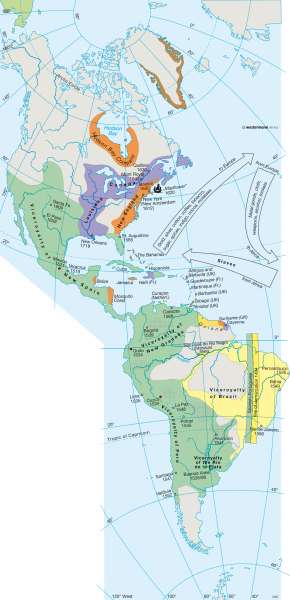European colonization in the mid-18th century
The Americas - States and history
978-3-14-100790-9 | Page 124 | Ill. 2

Information
In 1495, the Spanish Crown made the change from the original concept of mere trade expansion to that of colonisation and settlement conquest. With the establishment of the Audiencia of Santo Domingo in 1511, the cornerstone was laid for an organised colonial administration. This was after the conquest of Mexico by Hernando Cortés and Peru by Francisco Pizarro. Audiencias were expanded through Mexico, Panama, Guatemala, Colombia, Peru, Bolivia and Chile and Spain became the most powerful colonial power in the New World.Non-Spanish colonial occupation
In 1500, Brazil was captured for the Portuguese crown by Pedro Alvares de Cabral. The attempt at a government promotion of colonial penetration by a system of land donation failed. The initiative of the privately organised and operated paramilitary Bandeiras (late 16th Century), on the hunt for precious metals and Indian slaves, penetrated into the interior and launched the Portuguese colonial empire.
Other European colonial possessions in Central and South America were less significant. England only claimed Belize and the Mosquito Coast of the islands of Jamaica, Trinidad, Tobago, Barbados and the Bahamas. France struggled with Guadeloupe and Martinique, but claimed a number of Caribbean islands. The Dutch were in Guyana since the 16th Century, shortly after which, the British arrived. In 1667, England exchanged its claim on Suriname in return for the Dutch "New Amsterdam" (New York).
Europeanisation of North America
In North America, the first colonialisation attempts failed due to harsh living conditions, diseases, resistance by the Indians, and rivalries between the European powers. Despite the founding of St. Augustine, Florida (1565), the real history of settlement there did not begin until the 17th Century. Initially, England took out a charter for founding the colony, which was issued to the London Company in 1606 by James I. Jamestown (1607) became the nucleus of tobacco production in the economically lucrative colony of Virginia. The Pilgrims of the "Mayflower", which set sail in 1620, populated New England. The areas around the Hudson Bay were opened up in 1670 after the British Fur Company had been given the local territorial and trading rights.
The first major French foundation was Quebec (1608) on the St. Lawrence River. The fur trade and the Indian mission there led the French ever deeper inland to the Great Lakes and the Mississippi River Basin. In 1682, they arrived at the mouth of the Mississippi on the Gulf of Mexico, in the hope of finding a way to the Pacific Ocean. In 1718, New Orleans was founded. In 1721, Greenland was colonised by the Danes and converted to Christianity.
K. Lückemeier; Ü: Colette Fleming




